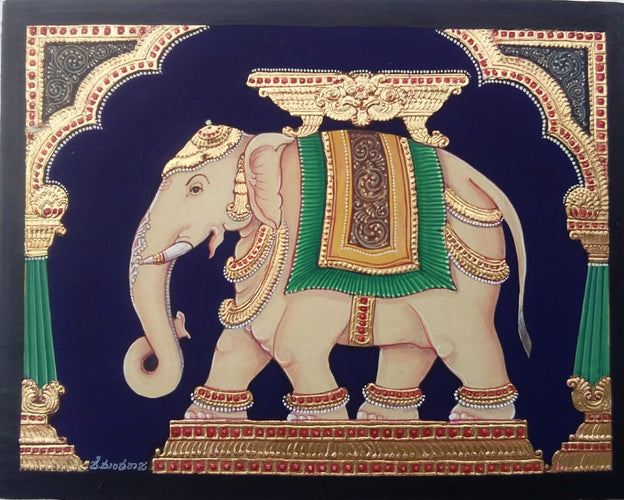Mysore paintings are a traditional form of South Indian painting that emerged from the city of Mysore in Karnataka. Known for their graceful lines, muted color palettes, and rich iconography, Mysore paintings often depict Hindu deities, mythological scenes, and royal figures. These artworks are celebrated for their fine craftsmanship, attention to detail, and the use of gold leaf, which adds a luminous quality to the paintings. Mysore paintings reflect the rich cultural heritage of Karnataka and continue to be a significant representation of Indian art.
The style of Mysore painting is characterized by its delicate and intricate lines, soft colors, and extensive use of gold leaf. The figures are drawn with precision and are often elongated, with expressive faces and elegant postures. The compositions are balanced, with a clear emphasis on symmetry and proportion. Unlike the bright, vivid colors of Tanjore paintings, Mysore paintings use a more subdued palette, creating a sense of calm and serenity. The use of gold leaf enhances the detailing of ornaments, crowns, and other embellishments, giving the painting a divine and ethereal quality.
History
The origins of Mysore paintings can be traced back to the reign of the Vijayanagara Empire in the 16th century, where the art form began to flourish under royal patronage. Following the empire's decline, many artists migrated to the Mysore region, where they received support from the Wodeyar kings. It was during this time that Mysore painting evolved into a distinct style, with influences from traditional South Indian temple art and Persian miniatures. The Wodeyar kings not only commissioned paintings for royal courts but also for temples and religious purposes, leading to the development of religious and devotional themes that became central to the art form.
Mysore paintings primarily revolve around Hindu religious themes, with an emphasis on depictions of gods, goddesses, and scenes from the epics like the Ramayana and Mahabharata. Popular subjects include Lord Krishna, Lord Ganesha, Goddess Saraswati, and Goddess Lakshmi, often shown in richly detailed settings. These paintings are not just artistic representations but are also intended for spiritual contemplation, with each figure symbolizing divine attributes. Royal portraits, scenes of court life, and depictions of flora and fauna are also common themes in Mysore paintings.
Materials and Methods
Mysore paintings are traditionally made on handmade paper or cloth that is first treated with a mixture of paste and tamarind seed powder to create a smooth surface. The drawing is outlined with thin, fine lines, and natural pigments are used to color the painting. Colors are made from organic sources like minerals, plants, and even precious stones, providing the artwork with rich and long-lasting hues. Gold leaf is carefully applied to areas that depict jewelry, crowns, and other intricate elements, adding a shimmering dimension to the painting. The final step involves burnishing the painting with a smooth stone to give it a polished and luminous finish.
Significance
Mysore paintings hold great cultural and religious significance in South Indian art traditions. They are not only admired for their aesthetic beauty but also for their spiritual depth, often used as objects of worship or meditation. The meticulous craftsmanship and use of gold leaf make them valuable both artistically and monetarily. Mysore paintings have played a crucial role in preserving the region's artistic heritage, with artists continuing to pass down the techniques and knowledge from generation to generation. Today, these paintings are prized collector’s items and are featured in temples, museums, and art galleries around the world. They represent the enduring legacy of Indian classical art and its influence on the spiritual and cultural life of the region.
FAQs
Are the gold leaf accents real in Mysore paintings?
Yes, the gold leaf used in Mysore paintings is real, adding to their artistic and monetary value. This unique feature gives the paintings a rich, luminous quality that is characteristic of this art form.
Do you ship Mysore paintings internationally?
Yes, we offer international shipping. Shipping costs and times will vary based on the destination. Please refer to our shipping policy for detailed information.
How do I care for my Mysore painting?
To maintain the quality of your Mysore painting, avoid exposing it to direct sunlight, moisture, or extreme temperatures. Dust it regularly with a soft, dry cloth, and consider framing it behind glass for added protection.
Can I customize a Mysore painting?
Yes, we offer customization services for Mysore paintings. You can request specific themes, sizes, or compositions to suit your preferences. Please contact us for details on how to place a custom order.
Show Less
